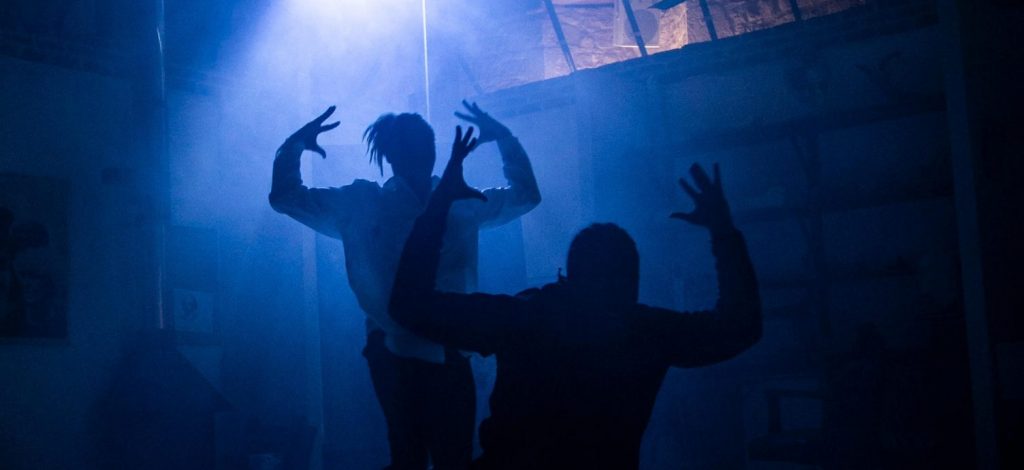
Live Performance: Saturday 5 September – SOLD OUT
Online Screening: Saturday 5 September – Tickets Launched
channelling three distinct camera angles the performance
will be live streamed to an online audience
Full price – £16.50
Members price – £6.50
Discount for members using access code
A ground breaking synthesis of performance and art in the recreated studio of Elisabeth Frink. Set within the largest thatched building in the country, this one off performance production is created in response to these challenging and creatively vital times. A synthesis of the legacy and output of Frink, the repercussions of COVID-19 and the Black Lives Matter movement forms the basis of this pioneering contemporary dance performance.
Matsena Performance Theatre is Anthony and Kel Matsena – Zimbabwean born and Welsh raised brothers. Through their experience of being brought up in an Afrocentric house and having Eurocentric schooling, they have built a love and curiosity for telling stories that express themes of culture, race, change and belonging. These two incredibly talented young brothers are adding their voices to a movement that included mass uprising, civil unrest and cries to stay connected and not numb to the world around them.
Referring to both the global pandemic and the numerous cases of injustice and conflict around the world Anthony says, ‘there has been a whole lot of loss and an insurmountable amount of fear that’s crept up in people’s lives and it’s become normal which is frightening… that I see people’s lives being lost as numbers or statistics.. that worries me.’ The Title behind the live and online performance is the unsettling question ‘are you numb yet?’ Kel astutely discusses this discomforting phenomenon of instant global news, where information overload means that although ‘the news of last week is extreme […] it’s still last week’s news’. Very few artists and performers are successfully dealing with these unsettling notions and the sudden awareness of how race has been a blinding problem for so many.
In many ways the natural medium with which to have these conversations is through the arts and very particularly live performance. Anthony points out that there is a parallel between life and live performance that does not occur in other art forms. ‘I like the high stakes of theatre.. if the magic of coping with what goes wrong is relevant to our lives then time is linear. Life is about coping with whatever happens, sometimes in theatre something falls.. a light goes.. someone feints. you deal with it and still perform.. and that part of it.. that’s the magic for me.’
The realisation is so recent in our history that we are still grappling with the language with which to discuss it. Kel and Anthony are not here to raise their voices, the performance is powerful embodiment of a language that does far more and asks the question about being alive to others concerns.
The title “ Geometry of Fear” was conceived by Art critic Herbert Read and refers to a phase of British figurative sculpture expressing post-war anxieties. Dame Elisabeth Frink, a child of her time and much affected by growing up during the war embodied these sculptors’ work and aspirations. These visceral and tortured looking sculptures caught Frinks wider interest in the Human condition and the language of sculpture that Frink inhabited. Frink’s goggle heads are perhaps most representative of her work and preoccupation with the inhumanity inherent in the blank and unapproachable archetype of power personified by the male figure. The goggles are polished, reflecting back any scrutiny, any chance at a mutual exchange. They could be seen as a political or institutional body, and are every cruel act anonymously hidden behind the term ‘they’ where power is so often abused. In the words of Elisabeth Frink, ‘we no longer respond properly to atrocities, if I had a religion it is that every man should be free in his spirit’. With the performance happening in and around the actual building that Frink created her sculptures, the parallels across time and artist cannot be ignored. As Anthony says, ‘fairness and equality should be the standard and it’s never been’. Put simply by Kel, ‘if we believe in equality, we have to fight for it.’
‘Finally, people are having conversations that should have been had centuries ago but there is uncertainty about how we deal with those conversations.’
Kel Matsena
‘We cant do a lot but we can use what we have and that’s our art, to try and affect change.’
Anthony Matsena
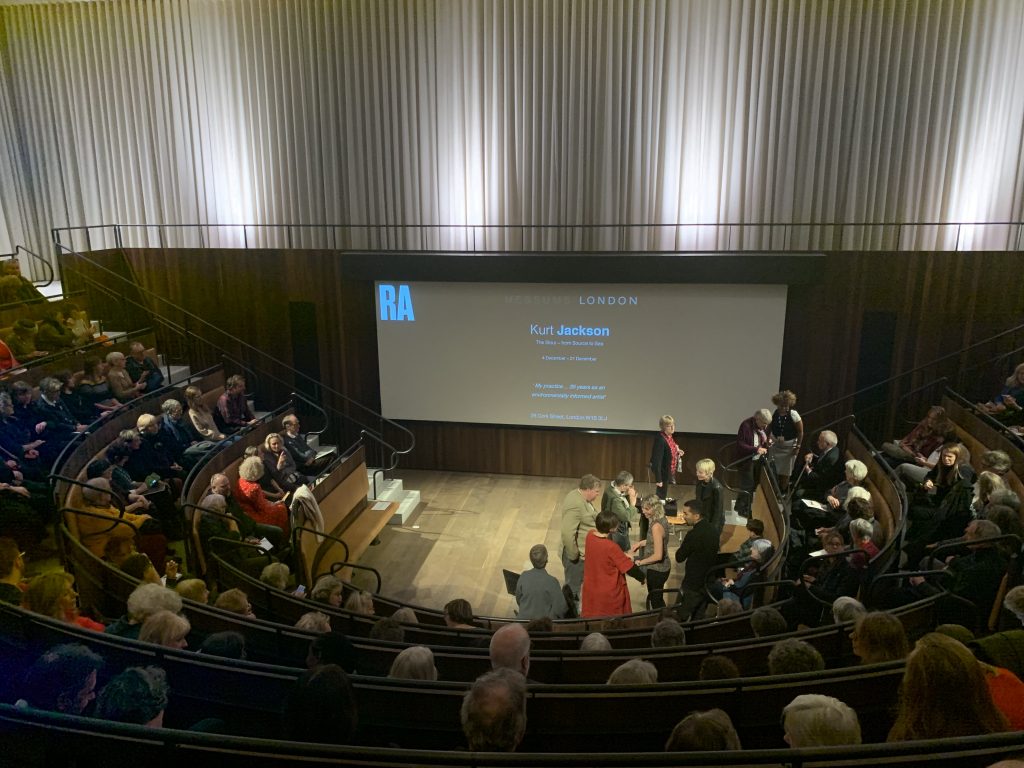
An exhibition of new paintings by Kurt Jackson opened last week with great excitement. ‘My Father’s River’ traces Kurt’s journey along the River Stour in East Anglia.
The day began with a packed curator’s tour of ‘My Father’s River’ led by Johnny Messum, before moving to the Royal Academy Lecture Theatre where Kurt spoke to over 300 people about his work both as an artist and an environmentalist. He talked through the major projects that have come to define his practice as an environmentally informed artist.
His residency aboard the Greenpeace ship Esperanza was described in vivid detail alongside excerpts from a BBC documentary.A clip of Greenpeace activists attempting to document damaging fishing practices on a small rib in rough seas while Kurt is continually drawing, documenting the action around him encapsulates his determination and versatility as a painter.
This versatility was also apparent in Kurt’s long stint as artist-in-residence at Glastonbury Festival. The rapid brushstrokes that usually describe the natural landscape were now applied to vast crowds and wild performances. Kurt is clearly a polymath; from designing trophies for environmental awards, working in bronze, pewter and a more recent foray into glass, his enthusiasm for making was increasingly evident.
For most of the talk however Kurt discussed the landscape painting for which he is most well known. That Kurt’s paintings so energetically and vividly evoke these landscapes is less surprising after seeing footage of him painting outside in the elements, canvas spread out on the beach. He gave real insight to the excitement and love of nature behind his works – from protected and fragile environments of rich biodiversity to patches of grass by service stations.
After the talk, a crowd headed towards Messums London for mulled cider and mince pies surrounded by Kurt’s magnificent paintings. Beginning at the river’s source on Wratting Common in Cambridgeshire, the paintings document the river as it winds through the East Anglian countryside, along the border of Suffolk and Essex to where it meets the North Sea at Harwich.
Kurt often painted the Stour with his father who lived by the river for three decades, swimming in it every day. In this body of work, Kurt has rediscovered the river that was so important to his father as well as capturing a fragile and varied landscape with the eye of a keen environmentalist.
‘Source to Sea’, or ‘My Father’s River’, is on show at Messums London until 21st December, followed by exhibition of new works following the Fonthill Brook and River Nadder at Messums Wiltshire. ‘Fonthill Brook’ opens in the Long Gallery at Messums Wiltshire 10 January – 16 February 2020.
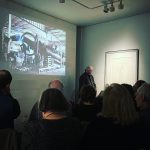
ARTIST’S TALK: 27 & 28 November 2019
Albert Paley’s talk and slide show at Messums London traced the 50 years that he has been working in metal; from making intricate pieces of gold and silver jewellery measured in centimetres to sculptures the size of houses, 30 feet high.
At the root of all his designs are his drawings in pencil he said, that fill the drawers and sketchbooks of his 50,000 square foot studio in Rochester, New York. ‘Drawing is fundamental – it gives you a vocabulary so you can understand what you see,’ he said, adding that his jewellery expressed ‘an attention to detail, a refinement of line.’
Thinking through doing is how he works he says, and as his technical skill has grown so has the ambition of his sculptures. ‘Technique is a way to manage thought development; I don’t know what I’m doing until I start working,’ he explained.
Born in Philadelphia, Paley attended the Tyler School of Art where his earliest works were direct carvings in wood and stone in the tradition of Henry Moore and Barbara Hepworth and he showed us a picture of a delicate, sensuous Rodin-esque sculpture of a woman he carved out of white marble.
Paley’s training was not only manual but academic with an education in the techniques of Renaissance masters like Cellini, Leonardo and Michelangelo as well as the Mannerist and Viennese Secessionist painters of which he is particularly fond.
Early in his career Paley had imagined he would be a goldsmith ‘for the rest of my life,’ but irked by the perception of jewellery as a ‘minor art, rather than what it truly is – a fine art,’ he started making bigger pieces starting with a set of enormous gates facing the White House.
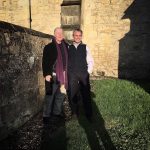
Albert with Johnny Messum at Messums Wiltshire
‘Using metal is like drawing in space’ he said. ‘Punching, ribboning and blasting, the gates enriched my public exposure and allowed me to interface with architecture, pushing me into a new arena’ he said. Going through gates is an act of passage, he said, ‘they are ceremonial archways.’
Consistently throughout all his work appear flowing, sinuous, natural forms – in particular vegetation – within ordered, mathematical structures.
‘My design philosophy is organicity in that one line begets another whether it is in metal or any other material,’ he says.
In 1979, Paley was asked to make two gates for the antechamber of the New York Senate. The Albany gates, as they are known, reflected the nascent fear of terrorism in public spaces in their spiky, thorn-like design protecting the heart of government.
In his talk, Paley rattled through an astonishing array of gates and fences, benches and grills and freestanding ‘sentinels’ or sculptures that he had made, all created with an unerring sense for form and each bigger than the last. He describes his studio as his sanctuary adding that his 16 staff were like the members of an orchestra of which he is the composer.
Paley said he tried to use design to bring a sense of modernity into historic spaces and talked much about the play of light and shade in his work and the beauty of rustification.
The Fence of the Hunter Museum is one of Paley’s wildest works to date where the lines of metal seem to hover in space like banners or whips.
In his recent works, Paley has tended increasingly to paint metal and patinate it in a range of hues.
‘Colour solicits emotion’ he said. ‘Shadows are beautiful but ephemeral and colour adds into that.’
Pointing to a range of eight sculptures he made to adorn the staircase of the Wortham Center for the Performing Arts in Houston, he said the effect was to create ‘a whole sensuality of folded metal, play of light and tromp l’oeil.’
The talk ended with a description of how Paley created the gates for St Louis Zoo, and we saw a fine picture of him next to a metal rhinoceros he had made.
In a question and answer session after his talk somebody in the audience mentioned that the computer has led to the dematerialisation of form and that the importance of objects in the realm of fine art is in a state of flux.
‘Fundamentally, art deals with the human condition’ replied Paley, ‘whether it’s a personal response in canvas or in the public arena like the music of Wagner. Metal articulates emotion beautifully; there is an honesty and integrity to being a blacksmith. It’s all about sharing that language.’
Albert Paley’s talk was part of his exhibition ‘Drawings and Sculptures’ at Messums London which comprised of his architectural two-dimensional works and smaller scale sculptures and maquettes. An exhibition of Albert’s ‘Large Sculptures and Architectural Works’ including examples of his monumental gates, will be open at Messums Wiltshire 4 July – 30 August 2020.
Press coverage:
Financial Times – How to Spend It ‘Mind-blowing Metalwork at Messums London’
Artlyst ‘Three London Shows November 2019’
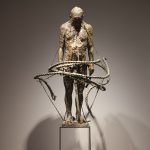
Laurence Edwards’s work has found its way into stately homes, public parks and domestic spaces. The versatility of environment that his work has thrived in showcases its ability to own the space around it, no matter how vast or small, domestic or wild. The difference between a thirteenth century tithe barn in Wiltshire and a Mayfair gallery might be boundless but the striking and enigmatic figures of Laurence Edwards populate both spaces with an atmosphere of mysterious omniscience.
The variability, however, between the individual pieces is exemplified by their curated groupings and placings. The collection of works in Wiltshire for example demand more from their space. Their volumous and shadowy stature possess their own kind of gravity while the pieces in London are preoccupied by more delicate forces; reflection, balance and line.
Wiltshire – Volume
Perhaps the first impression one might get from walking into the Barn and finding yourself amongst these towering characters is the effect of their scale. Not only scale in relation to the building or even to each other but to the viewer. One is confronted by the uneasy feeling of being looked down on from a height or the humbling experience of being eye to eye with a bust larger and taller than oneself. The lofty ceilinged space gives a sense of cathedral-esk verticality that lends a biblical tone to the weighty subjects.
London – Line
The preoccupations inherent in the pieces in Cork St are less to do with volume and more to do with tensions and forces such as that of rope, ties and supports. They elicit notions of the push and pull of encasement and a desire to break free, or the heaviness of the burden many of them carry. Often they suggest some conflict with visible outer forces and often invisible inner forces pertaining to the male psyche. Whatever their struggle these pieces are created with a lighter hand, they are the drawn line solidified in bronze.
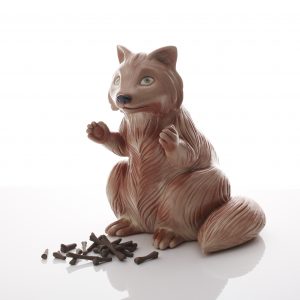
Following an outstanding opening of Malene’s work in Cork St, Malene Hartmann Rasmusen’s exhibition ‘Fantasma’ has relocated itself to Istanbul to be part of ‘Beyond the vessel: Myth and Metamorphosis in Contemporary Ceramics’.
It is too often the case that provincial artists (responding to their own culture or the mythologies of their own community) have to enter main, often western, centers of the world in order to make their name. The koc foundation in Istanbul is upending this. This exhibition looks decidedly outward and pays particular attention of the mythologies of different communities while highlighting the unifying quality of the ancient medium of clay itself.
Malene has drawn inspiration from the cultural outpourings of Scandinavia and her own past. Her work itself is very much responding to a journey that she is on and we are delighted to play a part in the physical journey of these works from Denmark to London and to Istanbul.
Shortly prior to exhibiting in Messums London Malene completed a ceramics residency at the V&A which has informed the works on show.
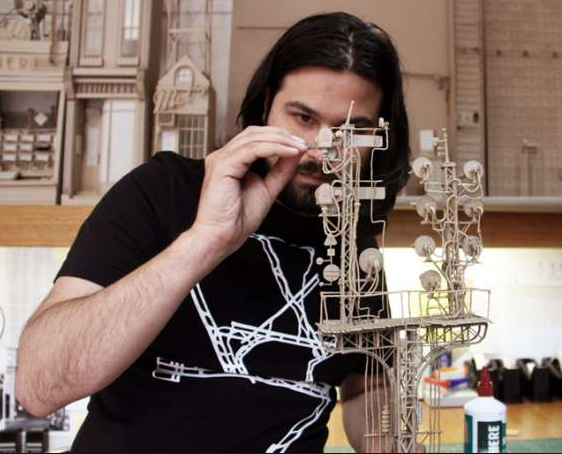
We are delighted to announce that Messums will now represent the Australian artist Daniel Agdag in Europe and North America. Following his sell-out show at our sister gallery Messums Wiltshire, Daniel’s collection of intricate scalemodels can be viewed here in Cork Street until this Friday 12 July.
Daniel is an artist and filmmaker based in Melbourne, Australia, whose practise sits at the nexus of sculpture and motionography. He creates highly detailed sculptural pieces that have been described as architectural in form, whimsical and antiquated in nature and inconceivably intricate.
Daniel predominately works in cardboard. Drawn to its utilitarian origins and monochromatic presentation, he creates a paradox of fragility and strength with structures that resemble architectural forms and machines by utilising a medium that is essentially paper and preserving them under glass vitrines or bell jars.
Whilst his work is predominantly realised in cardboard he has made work in steel, wood and glass in recent years as part of translating his elaborate ideas into large scale public art sculptures, in 2014 he completed a large-scale public commission ‘The Inspector’ in Abbotsford, Melbourne.
The son of Armenian immigrants, Daniel Agdag studied Fine Art before his interest in moving image drew him to filmmaking. He received a Masters in Film and Television from the Victorian College of the Arts in 2007.
He has exhibited solo shows in Melbourne and New York and been presented at several international art fairs: Melbourne Art Fair; Sydney Contemporary; Art Central Hong Kong; VOLTA Basel; Art Fair Tokyo. His work is held in private collections in the United States, Japan, Hong Kong, Australia and Europe. He has completed several private commissions, notably for Hermès Paris.
To see our collection of Daniel’s artworks click here
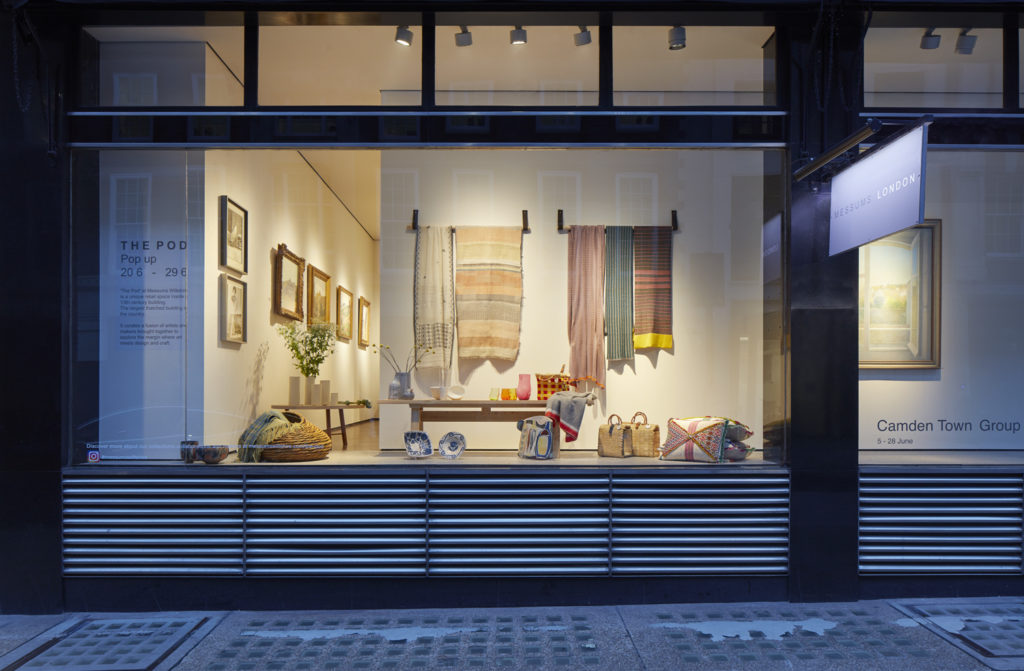
Until Friday 28 June
For one week the team of curators from the Pod at Messums Wiltshire, our sister gallery in Tisbury, will host a pop-up exhibition in the windows of Messums London on Cork Street to showcase works by talented British and international makers.
The Pod at Messums Wiltshire is a unique retail space inside a 13th century tithe barn, the largest thatched building in the country. It presents a fusion of artists and makers brought together to explore the margin where art meets design and craft. Artist makers include those working in wood, ceramics, textiles and glass from a range of makers who are original in their execution of the creative process. Each item found has a story behind it; a story of the maker and their journey and a story of the end product. All handmade, all using materials in a way that demonstrates their true nature.
Each artisan understands the material they work with to create works to be valued and cherished in a way that is the antithesis of a throw away, quick fix society.
There are makers that are interested in sustainability in the textile industry, using offcuts and surplus fabrics in an ingenious way to produce finished pieces that are at once visually arresting and practical.
Whether it is ceramic or paper, each item is made by hand in small quantities by individuals or as part of a small studio so traceability is possible and connections are made by us with the makers create unique pieces that are often a response to our magnificent setting – a 13th century tithe barn that is one of the finest in the country.
They range in price according to the labour involved and scale of the finished works as we support local makers, as well as national and international artists and artisans.
For more information click here